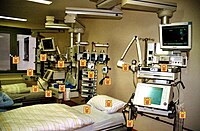
Photo from wikipedia
BACKGROUND Hospital-acquired pressure injuries (HAPIs) typically develop following critical illness due to immobility and suboptimal perfusion. Vitamin D helps to maintain epithelial cell integrity, particularly at barrier sites such as… Click to show full abstract
BACKGROUND Hospital-acquired pressure injuries (HAPIs) typically develop following critical illness due to immobility and suboptimal perfusion. Vitamin D helps to maintain epithelial cell integrity, particularly at barrier sites such as skin. It is unclear whether vitamin D status is a modifiable risk factor for HAPIs in critically ill patients. Our goal was to investigate the relationship between admission 25-hydroxyvitamin D (25OHD) levels with the development of HAPIs in surgical intensive care unit (ICU) patients. METHODS We performed a retrospective cohort study of patients admitted to surgical ICUs at a major teaching hospital in Boston, Massachusetts. To investigate the association of 25OHD levels with subsequent development of HAPIs, we performed logistic regression analyses, controlling for body mass index, Nutrition Risk in the Critically Ill score, ICU length of stay, and cumulative ICU caloric or protein deficit. RESULTS A total of 402 patients comprised our analytic cohort. Each unit increment in 25OHD was associated with 11% decreased odds of HAPIs (odds ratio [OR] 0.89; 95% CI 0.840.95). When vitamin D status was dichotomized, patients with 25OHD <20 ng/mL were >2 times as likely to develop HAPIs (OR 2.51; 95% CI 1.065.97) compared with patients with 25OHD >20 ng/mL. CONCLUSION In our cohort of critically ill surgical patients, vitamin D status at ICU admission was linked to subsequent development of HAPIs. Randomized, controlled trials are needed to assess whether optimizing 25OHD levels in the ICU can reduce the incidence of HAPIs and improve other clinically relevant outcomes in critically ill patients.
Journal Title: Nutrition in Clinical Practice
Year Published: 2019
Link to full text (if available)
Share on Social Media: Sign Up to like & get
recommendations!